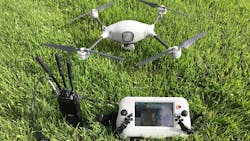Lockheed Martin will provide a drone fleet to the Swiss Army
In this week’s roundup from the Association for Unmanned Vehicle Systems International, which highlights some of the latest news and headlines in unmanned vehicles and robotics, the Swiss Army contracts with Lockheed Martin for a drone fleet, students develop an autonomous golf cart, and a new firefighting drone is launched.
Swiss Army contracts Lockheed Martin for fleet of Indago 3 small UAS
In Switzerland, the Federal Office for Defence Procurement (Armasuisse)—a federal agency of the Swiss Confederation—has contracted Lockheed Martin for a fleet of Indago 3 small UAS, with options for spares, training and tech support and additional systems for the Swiss Army.
The first phase includes manufacturing development to optimize the Indago 3’s configuration to meet Swiss Army requirements, which will include the integration of a transponder for sense and avoid; installation of the Silvus Technologies’ radio; and implementation of Lockheed Martin CDL Systems’ VCSi Touch SUAS Ground Control System software that includes access to Swiss maps, including digital terrain elevation data (DTED), and Geofencing.
The first set of optimized systems will be delivered later this year. The remaining systems will be delivered several months following the first delivery.
“Indago 3 is uniquely qualified to support the Swiss Army’s mission needs,” says Steve Fortson, UAS Portfolio manager at Lockheed Martin.
“Indagos operate very quietly from relatively low altitude and provide high fidelity sensor imagery. They are simple to use and require minimal training so soldiers can quickly execute their mission. The Silvus Technologies radios also deliver best-in-class performance and efficiency in a miniature package. They’re ideal for use in portable and embedded applications where size, weight, power and cost are key.”
Indago UAS provide aerial reconnaissance in environments unreachable by normal fixed-wing UAS. The Indago 3s that the Swiss Army is receiving will support tactical level reconnaissance and surveillance to support a variety of missions including information collection, search and rescue, disaster relief and battle damage assessment.
Lockheed Martin notes that depending on payloads and operating environment, Indago 3 has a flight time of up to 50 minutes, a range of 10 kilometers, a cruise speed of 25 knots and dash at up to 40 knots.
The UAS is also capable of operating at temperatures as low as 30-degrees below zero and as high as 120 degrees Fahrenheit. Cyber-secure with high fidelity color and infrared 3-axis stabilized sensors, the UAS, which weighs approximately five pounds, can be transported via a single backpack and deployed in less than three minutes.
Florida Poly researchers turning disused golf cart into solar-powered autonomous vehicle
In an effort to “advance cutting-edge research for years to come,” a team of researchers at Florida Polytechnic University (Florida Poly) is turning a disused golf cart into a solar-powered autonomous vehicle.
Funded by the University’s Advanced Mobility Institute, the project will support a $350,000 National Science Foundation award to develop a large-scale Hardware-in-the-Loop simulation facility for connected and autonomous vehicles (CAV).
“We are designing this in such a way that students can do research with it – it’s not just for demonstration,” explains Dr. Arman Sargolzaei, director of the Advanced Mobility Institute, which focuses on the development and testing of autonomous vehicle technology.
“We are making the code and applications available, so undergraduate and graduate students in the future can do research and implement different algorithms for different fields for autonomy, control systems, cybersecurity, power systems, and energy systems.”
The project brings together renewable energy and CAV technology, which Florida Poly describe as “two critical and emerging fields.” The renewable energy portion of the project is being led by Dr. Mohammad Reza Khalghani.
Student researches repaired the broken golf cart during the spring semester. They began working on the golf cart’s high-tech transformation at the start of the summer term. They first started by developing a simulated golf cart for demonstrations, before recreating the simulations on the actual vehicle.
“It’s becoming more and more important to have smart ways of transporting people. Smart technology has become a lot bigger recently and it’s only going to increase,” says electrical engineering junior Eduarda Farias, who is a research assistant on the project.
“Autonomous vehicles are one of the next technologies we are going to integrate into our lives.”
Recently, the team achieved a successful milestone by converting the cart into a drive-by-wire vehicle that can be controlled through a website. According to James Holland, a research assistant on the project that earned his bachelor’s degree in computer science from Florida Poly in May, the cart is now similar to a big remote-controlled vehicle.
“Our demo went really well with the golf cart rolling forward at 50 percent acceleration and then backward before coming to a stop on its own. It followed the commands to a T,” Holland says. “It was awesome to see the payoff of all our work and see it run.”
The team plans to continue working on the vehicle over the coming semester both in person and remotely.
“The next steps will include working on path following and object avoidance algorithms and programming – really developing the autonomous part of the golf cart,” Farias says.
EHang launches new firefighting drone
EHang launched a new version of its EHang 216 UAS as a firefighting drone.
Known as the EHang 216F, the UAS is specially designed for high-rise firefighting. In a company press release, EHang describes the 216F as “the world’s first large-payload intelligent aerial firefighting solution.” EHang demonstrated its new firefighting UAS during a launch event in Yunfu, China.
“We are pleased to introduce the EHang 216F AAV aerial firefighting solution, which solves difficult challenges in high-rise firefighting. The high-rise fire use case highlights the practical application of our passenger-grade AAV platform to different smart city management needs,” explains EHang’s founder, chairman and CEO, Huazhi Hu.
“The potential of our intelligent AAV technology platform is boundless. We will explore and develop more aerial solutions and use cases to empower smart cities.”
In one trip, the 216F can carry up to 150 liters of firefighting foam and six fire extinguisher bombs. The UAS can also reach altitudes of 600 feet.
According to the press release, the UAS quickly identifies the location of fire using a visible light zoom camera. It then “hovers precisely in position and uses a laser aiming device to fire (in succession) a window breaker, the fire extinguishing “bombs” and then a full-range spray of firefighting foam.” Multiple 216Fs can be deployed to rapidly extinguish the fire.
“Firefighting and rescue is a race against death. By taking advantage of the rapid response and centralized management of the EHang AAV platform, we can greatly improve the effectiveness of our efforts,” says Weiqiang Chen, the head of a fire station in Yunfu.
“EHang’s intelligent aerial firefighting solution can effectively solve difficult problems in fighting high-rise fires. This complements existing firefighting systems and will improve society’s ability to respond to emergencies.”
Compiled by Brian Sprowl, Associate Editor, AUVSI
Share your vision-related news by contacting Dennis Scimeca, Associate Editor, Vision Systems Design
SUBSCRIBE TO OUR NEWSLETTERS

